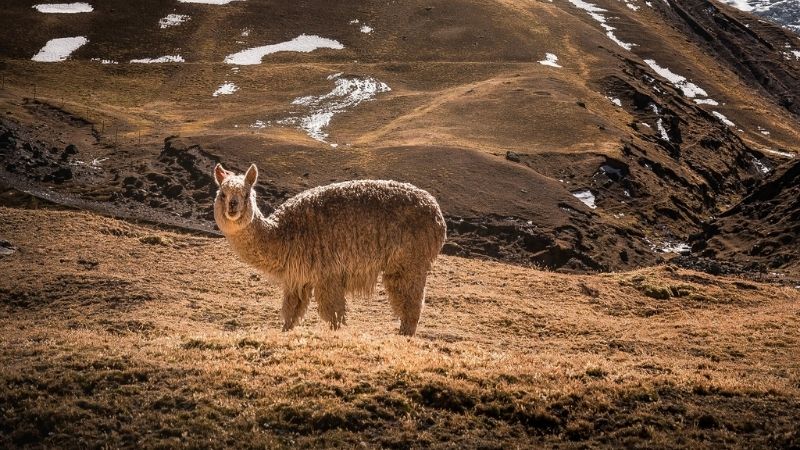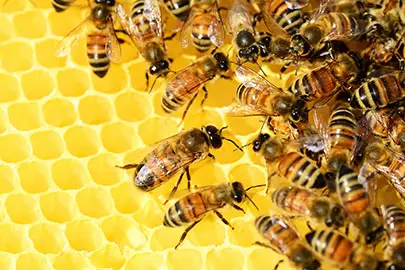What Is the Difference between Llama and Alpaca?
Llamas and Alpacas, despite both being members of the biological family Camelidae, are very different animals.
In this article, we’ll learn more about them, and you will understand why they are different.
The main differences between Llamas and Alpacas are size, fiber, temperament, and uses in history. Llamas are large, coarse haired creatures used primarily as pack animals or guards. Alpacas are smaller, fleeced, timid creatures traditionally used for their fiber production.
That’s it for the short answer, keep reading if you want for more information.
Llama
Physical characteristics
Some of the most noticeable differences between the two are that llamas are a lot bigger in general, with distinct head and ears shapes. Llamas typically stand between 42 and 46 inches at the shoulder, and weigh up to 400 pounds.

Of course because llamas are bigger animals, they have larger heads and ears. Their heads are elongated and have a rectangular shape.
Llama’s ears are usually described as banana shaped; they are long and skinny, and often stand straight up on their heads. Their faces and ears are both sparsely covered by short fur, though the fur between their ears is usually thicker.
Fiber
Llamas, unlike alpacas, have not been bred or prized for their fur.
Llamas’ hair is considered quite coarse at 25-34 microns thick, and has been deemed inferior as far as fiber goes. Rather than clothing or bedding, llama fiber is typically used to make rugs, ropes, or tapestries.
Temperament
Llamas have a notoriously bad reputation. While it is true that when they are overloaded or mistreated, they may kick, spit, or refuse to move, they are actually quite gentle and easygoing.
They are simply bold animals, not afraid to protect themselves or stand their ground. Moreover, they are also very alert and attentive to their surroundings and herd-mates.
Purpose/ use in history
Dating back three to five thousand years ago, llamas were domesticated for a couple of different reasons.
The primary reason is to be a pack animal, similar to a horse, reindeer, or camel. One of their most impressive qualities as a pack animal is that they can carry 20-25% of their body weight for several miles at a time. Even rough terrain and steep inclines are no problem for them since they are sure-footed and steady.

They were also raised for their meat and occasionally their fiber by the traditional times. Additionally, their bold nature and awareness of their surroundings make them good guard animals for other livestock.
Alpaca
Physical characteristics
Alpacas are typically recognized as the “cuter” of the two animals due to their smaller size, rounded heads, and small ears. They typically stand between 34 and 36 inches tall at the shoulders, and weigh an average of 150 pounds.

They have small, blunt faces which give them a similar appeal to small breed flat-faced dogs. They also have soft facial features and small pointed ears which tend to be covered in fluffy fleece.
Fiber
The natural fiber or fleece that is harvested from an alpaca is a soft, durable, and silky natural fiber. Alpaca fiber is around 20-28 microns thick and completely hollow, allowing it to be water-repellent and fire resistant despite being so fine.
It is even said to be superior to sheep’s wool because despite being so thin and lightweight, it is actually stronger and up to seven times warmer. Additionally, it lacks the characteristic itch of sheep’s wool and because it has no lanolin, it is less likely to cause allergies.

There are two types of alpaca, Huacaya and Suri, each with their characteristics and uses.
Huacaya fiber is similar to sheep’s wool in appearance and behavior, but is warmer, lacking prickles, and is hypoallergenic. It can be milled to create both lightweight threads as well as heavier yarns, and its natural crimp and elasticity makes it well-suited for knitting.
Suri fiber, alternatively, is similar to natural silk, and hangs off the body in long locks. Suri alpaca are recognized to be very rare, but there is debate on whether their percentage of the total alpaca population is extremely low, like 5%, or higher, up to 20%.
Regardless, the low population makes the Suri fiber quite rare. The high quality of the fiber, along with its lack of crimp makes it best-suited for woven goods; even being used by Armani to fashion men’s and women’s suits.
Temperament/ Behavior
Alpacas are intelligent, curious creatures. They are usually gentle and easy to handle, but have a tendency to be timid, so proper socialization and care is important. As both social and shy creatures, alpacas truly prefer being herd animals. Because alpacas are sensible and gentle with children, they make great 4-H projects, pets, and even therapy animals.
Purpose/ use in history
Dating back thousands of years, the Incas developed alpacas from their wild relatives, Vicunas.
Alpacas are too small to be a good pack animal, and they are instead treasured for their high-quality fleece. Their fine, silky fleece can be used to create countless textiles like coats, shirts, bedding, and accessories. Typically, adult alpacas are shorn once each year, similarly to sheep, so their fleece can be processed into textiles.
Differences between llama and alpaca
Differences in physical characteristics
Llamas are both taller and heavier than alpacas. Where Llamas can weigh up to 400 pounds and stand between 42 to 46 inches at their withers, alpacas usually weigh about 150 pounds and stand 34 to 36 inches tall.
They also have very different head shapes and structures. Llamas have long, rectangular heads and banana shaped ears whereas alpacas have small, rounded heads and short, pointy ears. Additionally, llamas have thinner, more sparse hair on their head and around their ears where alpacas have thick, fluffy fleece.
Differences in fiber
Llamas have coarse hair that is between 25-34 microns thick. It is usually made into heavy-duty items like rugs or ropes.
Alpaca fiber is soft and plush with a finer 20-28 micron thickness. Their wool is usually made into clothes, bedding, or accessories because of its durability and naturally, silky texture.
Differences in temperament
Although both llamas and alpacas are well-behaved and easy to handle with proper care and management, they each have distinct personalities.
Llamas tend to be stronger-willed and more bold. They won’t hesitate to kick or spit to protect themselves or other members of their herd. Alpacas, on the other hand, are generally more timid and reluctant to defend themselves. Overall, llamas usually have a negative reputation while alpacas generally have a good reputation.
Differences in purpose/ use in history
Their respective characteristics are what lead to their specific uses in history.
Llamas, who are strong and sure-footed, make great pack animals. They can carry 20-25% of their body weight and have been used to cover long distances for thousands of years. Additionally, their bold, protective nature makes them great guard animals for livestock.
Alpacas, on the other hand, are small and timid animals who grow plush fleece coats. Their predisposition to be timid herd animals makes them easy to handle. Aside from their primary use in the fiber industry, alpacas can also be used as pets or therapy animals for kids.
| Comparison Table | Llamas | Alpacas |
| Size | Between 280 to 450 pounds, 42 to 46 inches at the shoulder | Between 121 and 143, pounds 34 to 35 inches at the shoulder |
| Head & Ears | Elongated, rectangular head. Banana shaped ears | Small, blunt head shape. Short, pointed ears |
| Fiber | Coarse (inferior) wool 25-34 microns thick. Less variety in colors | Soft, silky fleece 20-28 microns thick. Wide variety of colors |
| Temperament | Bold and strong-willed. Have a bad rep for their willingness to defend themselves or act as in response to mistreatment. High awareness of surroundings and other animals | Curious and gentle. Typical herd animals. Can be shy or timid. Very easy to handle, even good with kids |
| Use/Purpose in history | Traditionally used as pack animals and for meat. Can act as guard animal for other livestock | Bred for their high quality fiber Also make great pets, 4-H projects, and therapy animals |
References and Resources
Alpaca Meadows. (2021). The Facts about Alpacas. Alpaca Meadows. https://alpacameadows.com/the-alpacas/the-facts-about-alpacas/.
Amelinckx, A. (2015, September 25). 6 Differences Between Llamas and Alpacas. Modern Farmer. https://modernfarmer.com/2015/09/difference-between-llama-and-alpaca/
Ella Ember. (2019, September 26). Alpacas vs. Llamas. Ella Ember. https://www.ellaember.com/blogs/resources/alpacas-vs-llamas.
Grannan, C. (2021). What’s the Difference Between Llamas and Alpacas? Encyclopædia Britannica. https://www.britannica.com/story/whats-the-difference-between-llamas-and-alpacas.
Miller, B. (2019, June 10). 6 reasons why llamas are the ultimate pack animal for hunting. goHUNT. https://www.gohunt.com/read/skills/six-reasons-why-llamas-are-the-ultimate-pack-animal-for-hunting#gs.sg6t2o.
Thompson, by: L. (2020, May 21). Learn the Differences Between Alpaca and Other Fibers: Kuoda Travel. Luxury Travel to Peru, Galapagos & Bolivia. https://www.kuodatravel.com/learn-the-differences-between-alpaca-and-other-fibers/.
Quesada, A. (2021, January 13). What’s the Difference Between a Llama and an Alpaca? Peru For Less. https://www.peruforless.com/blog/difference-between-llama-and-alpaca/.
Wikipedia. (2021, January 12). Alpaca fiber. Wikipedia. https://en.wikipedia.org/wiki/Alpaca_fiber.
Wisteria Suri Ranch. (2020, July 4). Wisteria Suri Ranch. https://wisteriasuriranch.com/suri-fiber/suri-vs-huacaya-fleece-characteristics/.






